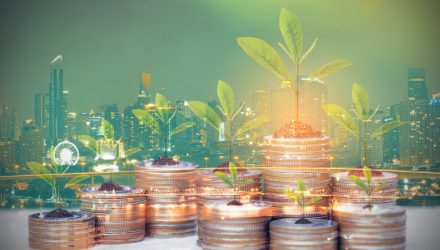The VanEck Vectors Green Bond ETF (NYSEArca: GRNB) is one of the pioneers in the green bonds ETFs and with that pioneering spirit comes the ability to overcome challenges in the form of a still nascent market for green bond data.
GRNB tracks the S&P Green Bond Select Index, which is “comprised of labeled green bonds that are issued to finance environmentally friendly projects, and includes bonds issued by the supranational, government, and corporate issuers globally in multiple currencies,” according to VanEck.
Green bonds are debt securities issued to finance projects that promote climate change mitigation or an adaptation or other environmental sustainability purposes. The new breed of green bonds gained momentum in the global market ever since the European Investment Bank issued the first green bond in 2007.
“When it comes to ESG investing, whether in equities or fixed income, the issue of data remains a knotty one,” said William Sokol, VanEck ETF senior product manager, in a recent note. “While, for the time being, there are still problems around the absence of relevant data, their reliability (standardization and third-party auditing remain challenges) or both, there are also concerns around how said data should be interpreted. The existence of, sometimes widely, differing ratings for the same company from different rating agencies provides evidence of this.”
Going Green Gains Momentum
Investors, including institutions, are clamoring for green bonds, a surefire sign that the space is growing and could continue to do so as more investors demand green initiatives in their investments. Private industries are also joining the fray, offering their own green bond issues that address investors’ needs for environmentally friendly initiatives.
As for the green bond data dearth, there are ways for investors to work around that.
“Projects like solar and wind are generally pretty unambiguously green and environmentally friendly, but it can be less clear when we talk about things like certain hydroelectric projects or clean coal,” notes Sokol. “Rather than relying on ‘self-labeling’, investors can rely upon a number of independent organizations that review green bonds to establish whether the projects financed are aligned with their green bond project taxonomies—akin to benefiting from a third-party “audit” of “greenness”—and are, consequently, green.”
Environmental assessment categories can include a company’s impact on climate change, natural resource use, and waste management, and emission management. Social evaluation categories can include a company’s relations with employees and suppliers, product safety, and sourcing practices. Governance assessment categories can include governance practices and business ethics.
In GRNB’s underlying index, bonds must “align with their taxonomy, which has been developed with climate scientists and is reviewed regularly to ensure it incorporates the latest research and technologies,” according to Sokol. “The taxonomy is designed to align with the overall objectives of the Paris Agreement, as described above, and to do so without incurring additional harm to the environment. The focus of the analysis is on the projects financed rather than the broader activities of the issuer, making this assessment more objective and straightforward.”
For more alternative investing ideas, visit our Alternatives Channel.
The opinions and forecasts expressed herein are solely those of Tom Lydon, and may not actually come to pass. Information on this site should not be used or construed as an offer to sell, a solicitation of an offer to buy, or a recommendation for any product.








